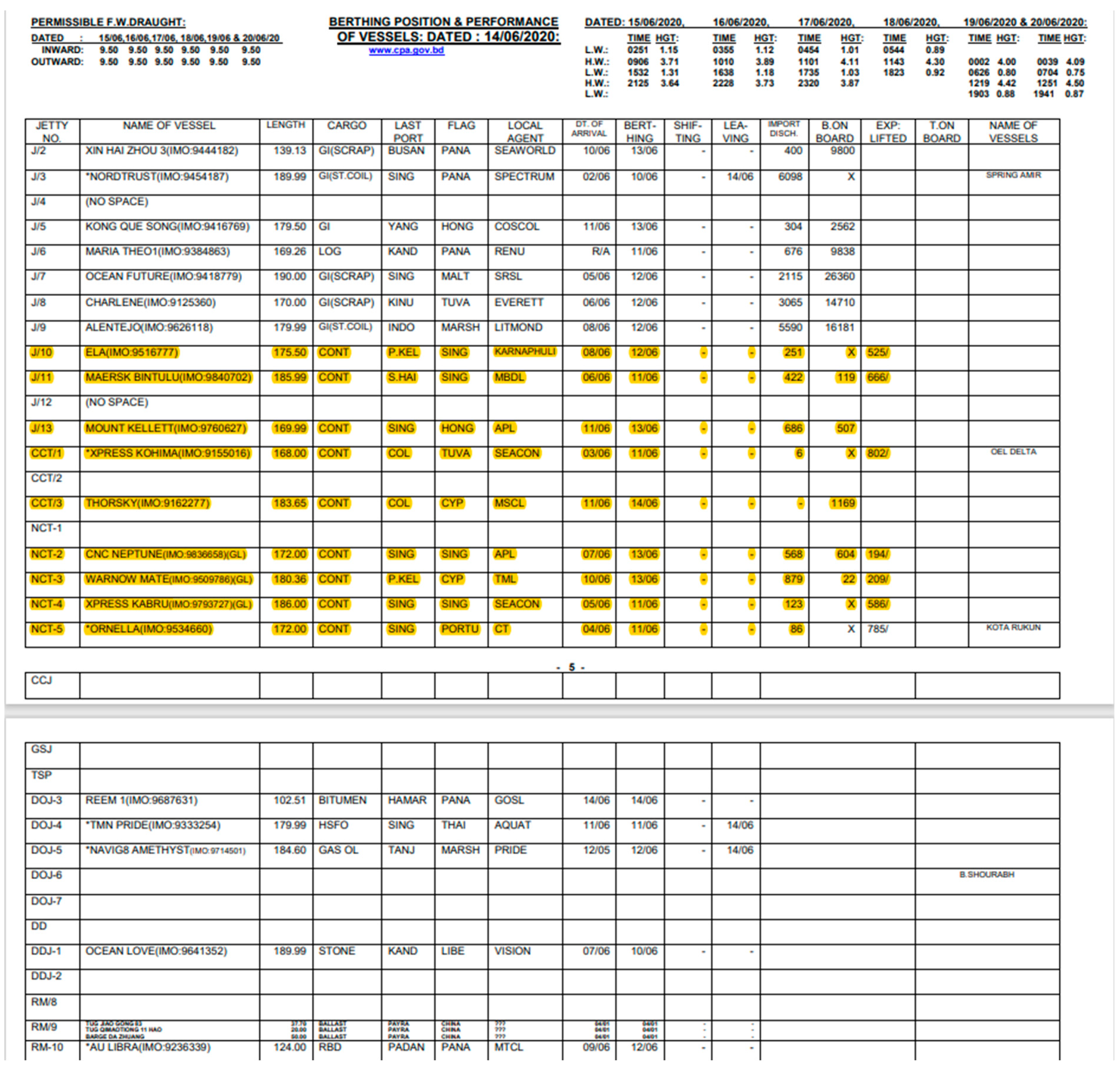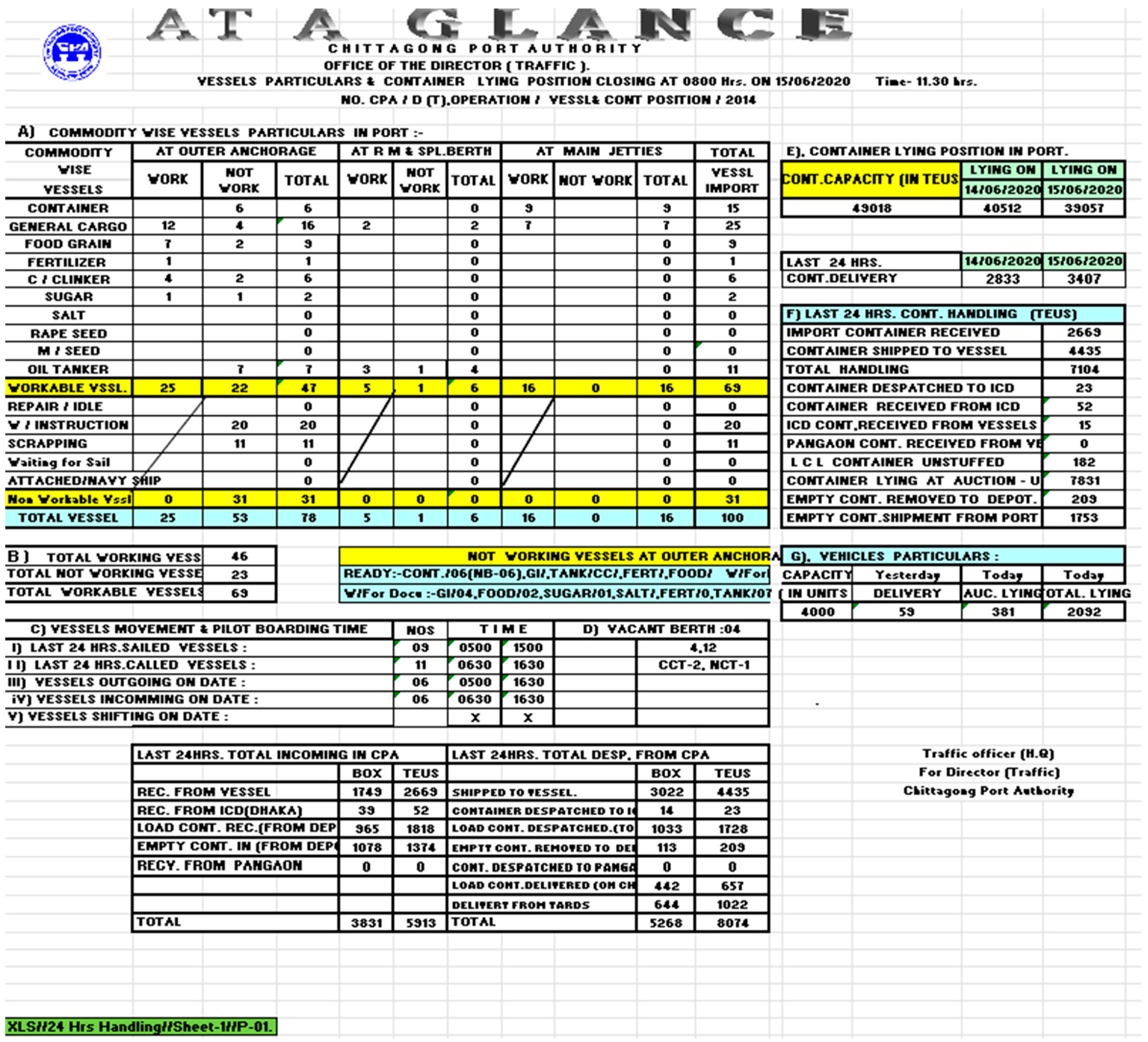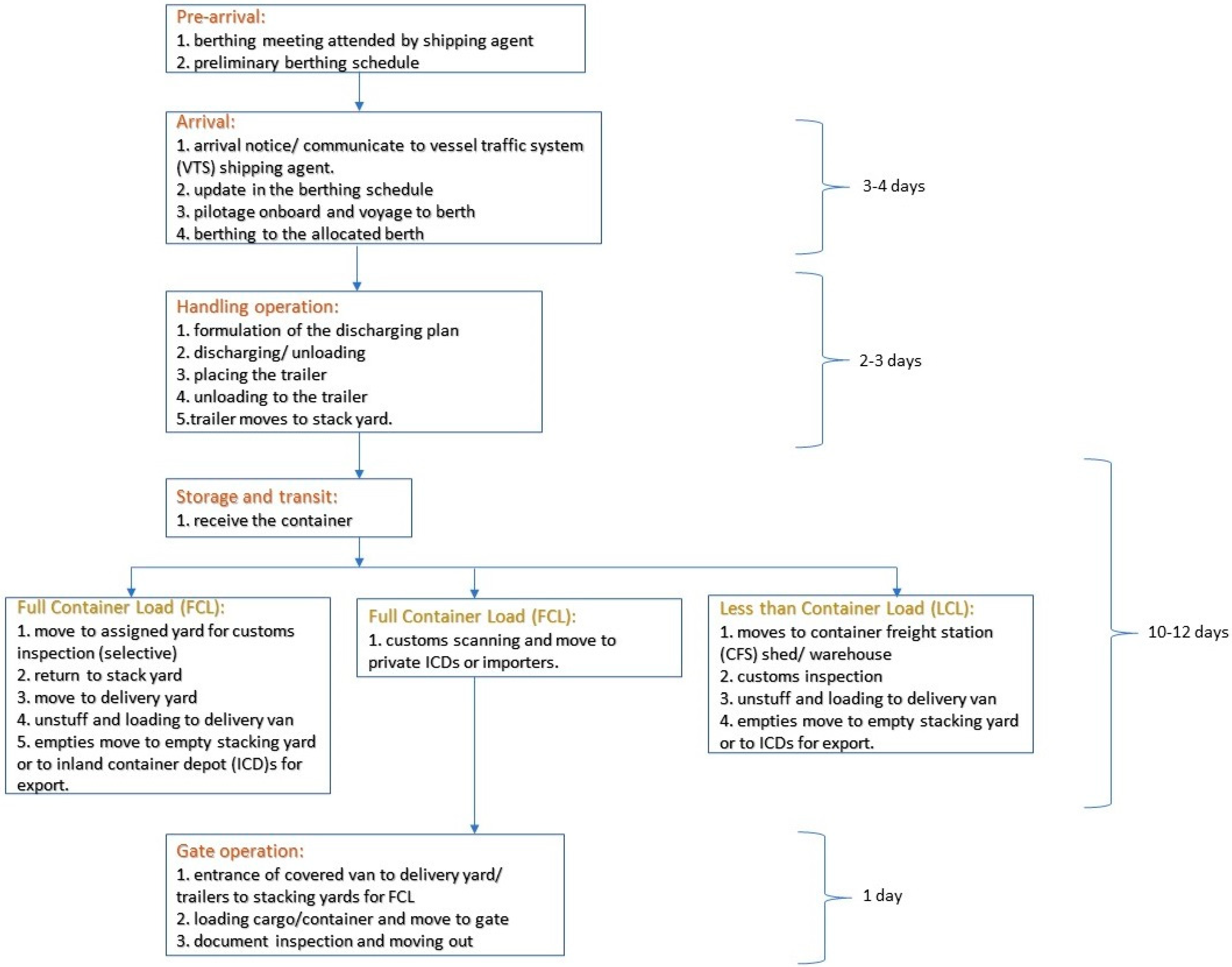4.1. CO2 Emissions and Findings from the Simulation-Based Scenario Implementation in Chittagong Port
Table 6 presents the estimated CO
2 emissions for Chittagong port only. The hinterland part is calculated in a later section, and the two are finally combined to understand the total port-hinterland emissions.
In the above calculation, the fuel consumption only considers an average size of vessel carrying 2000 TEUs, which is the average size of container vessels entering the port (the average size of ships and average container carrying capacity for the year 2020 is, respectively, considered 19,300 GRT and 1722 TEUs according to [
60]). It is important to mention that the consumption of the main engine within port movement is not taken into consideration for conducting the simulation. This is because no scenarios for the improvement of vessel speed in the channel is considered. Taking into account the channel characteristics in terms of depth, width and sharp bends, it does not seem possible to achieve a considerable improvement in terms of speed increase/decrease within this channel. Therefore, the vessel movement within the port from anchorage to berth will not change even if the performance in waiting and berthing is improved. As a result, the consumption of the auxiliary engine is only considered in the simulation rather than the main engine. It is observed from
Table 5 that the total fuel consumption and CO
2 emissions from the container vessels entering the CCT and NCT in 2020 are 10,500 tons and 33,663.00 tons, respectively. The fuel consumption per vessel is 10,000 kg and the CO
2 emissions per TEU are 19.80 kg from container vessels. The total per TEU emissions for the overall marine operations including the allied tug and pilotage services is 22.19 kg per TEU. For terminal handling, CO
2 emissions are 26.56 kg per TEU, whereas, in the gate, they are 32.59 kg per TEU. The total emissions including the waiting, berthing, terminal operation and final delivery through the gate are 81.34 kg CO
2 per TEU. There are not many similar studies in the literature, except for Huzaifi and Budiyanto [
12], which found that carbon emissions in the Jakarta International Container Terminal are 29.08 kg per TEU, but, as mentioned earlier, their study considered the inward services from berthing to taking the containers out of port. Another study by Yang et al. calculated that the CO
2 emissions per TEU in the port of Shenzhen are 23.49 kg [
22,
23]. Comparing the fuel consumption with previous empirical findings, noticeable differences can be seen, which are mainly due to the performance gap between Chittagong port and the above ports. That is, the performance of Chittagong port in every aspect of waiting, berthing, dwell time and gate operation time is not up to the mark. Therefore, policymakers have the opportunity from this calculation to look at the emissions status of the port and the performance issue from an environmental sustainability perspective.
The results from the simulation for 2020, 2022 and different scenarios are presented in
Table 7. As highlighted in the literature review section, the formulation of the scenarios is based on the infrastructural development and performance and operational efficiency of the CPA. As we can see, some infrastructural improvement was conducted from 2020 to 2022 (
Table 4); therefore, the impact of this improvement has been studied in the simulation. Moreover, due to the improvement in the infrastructure, changes in the performance and operational efficiency, mostly indicating improvement in the working hours and handling rate of gantries, are considered. As discussed in
Section 2.3, the working hours for gantries were 20 h, and the handling rate was 22 TEUs per hour in 2020; therefore, some improvement in the performance of these indicators is considered. Moreover, due to the improvement in the handling of gantry cranes along with other associated equipment, an improvement in the waiting and turnaround times is also considered. As discussed before, the median turnaround time for container ships is 0.7 days [
38] in ports, and on large ports, the average crane output can reach 25–50 moves per hour [
45,
46,
47]. Therefore, the scenarios include an increase in the working hour of cranes and equipment from 20 h to 22 h; an increase in the handling rate of gantries and other equipment from 22 TEUs per hour to 24 TEUs per hour; and, finally, an impact of the handling operation on the yard handling time reduction and a reduction in the customs time, which will have a corresponding impact on the waiting and turnaround time. It is important to discuss that, in the simulation analysis, the waiting time of ships, berthing duration of ships, number of ships in the berth, duration of a container staying at the yard, number of quay cranes per ship and their output, equipment availability and daily containers handling in the yard, and trucking and gate operations are considered as the input variables. Among these input variables, some are considered random, and some are considered fixed. The random input variables and their probability distributions are shown in
Appendix C. As discussed, the data for all these input variables are collected from the CPA web sources and some missing data from the Port and Traffic Department of CPA, examples of which are attached in
Appendix A and
Appendix B. On the other hand, the total lead time for containers, the throughput, the fuel consumption in various operations and the CO
2 emissions are considered the output variables in the simulation analysis. A sample sheet of the simulation is presented in
Appendix C.
The simulation results show that via the implementation of different scenarios the per TEU CO
2 emissions can be reduced from 91.92 kg in 2020 to 72.49 kg under Scenario III, that is, a reduction in the yard operation and customs time (duration), as this will impact the waiting and turnaround time. A step-by-step implementation of the different scenarios and the respective findings are discussed in the following parts. From
Table 7, it is observed that, even though there are some fluctuations in the total emissions, the mean emissions per TEU reduce from scenario to scenario, and there are further emission reduction opportunities with the existing capacity if a desired performance is achieved, which is examined in the simulation.
In 2020, the average total emissions were 150,310.44 tons, and they could be as low as 116,759.65 tons. The emissions per TEU were 91.92 kg on average, but could be as low as 65.39 kg. In 2022, the average total emissions rose a bit to 151,366.79 tons, but the emissions per TEU reduced to 87.52 kg on average and could be as low as 63.71 kg per TEU. In 2022, the operation of additional gantry cranes and other allied equipment were taken into consideration in the port operations as the port was supplied with new gantry cranes and other equipment starting from 2020 (
Section 2.3 and
Table 4). The operation of additional equipment has increased the total emissions, but the emissions per TEU show a reduction.
(i) Scenario I—Increase in the working hours for the quay crane
Under Scenario I, the working hour of the equipment increases from the base 20 h to 22 h, and the total emissions increase to 152,313.51 tons on average and the emissions per TEU decrease to 78.87 kg on average and could be as low as 57.90 kg. The increase in the total emissions seems not that high even though all the equipment is operating longer compared to 2022. This could be mainly due to the reason that a performance improvement of the handling operation always results in the reduction in the ships waiting and berthing time. This has reduced the total emissions to some extent, which has traded-off the increase in total emissions due to the equipment operational time increment.
(ii) Scenario II—Increase in the TEU handling rate per hour for the quay crane
In the case of Scenario II, a decrease in the total emissions is observed and the emissions per TEU decrease further to 74.11 kg and could be as low as 53.38 kg on average. In this case, an increased output per hour for gantries and other equipment is considered. In the base case, the output of gantries is 22 TEUs per hour, which increases to 24 TEUs per hour under this scenario. This increased the total throughput without impacting the consumption of fuel as the gantries and other equipment became more efficient and were able to handle comparatively more containers while their operating duration remained the same. Moreover, it improved performance impacts on the berthing and waiting time for ships. As a result, the total emissions as well as the emissions per TEU are reduced.
(iii) Scenario III—Port reduces the yard operating time and a simultaneous reduction in customs services
Under Scenario III, a reduction in the time required in the yard and for the customs procedures is considered. It is observed from
Figure 1 that the port requires a container to stay in the yard for 10–12 days on average for customs and other inspections and, finally, to unstuff and load the contents in a trailer, truck or covered van for final delivery. Moreover, the improvement in the quay operation in scenario II requires a simultaneous operational improvement in the yard as well; otherwise, there will be congestion in the yard leading towards a deterioration of achievement in the quay operation. Therefore, in the third scenario an improvement in the yard operation (duration) and customs services is considered to understand the overall impact on the emissions. This improvement has further impacted the waiting and berthing times without any increase in the equipment operation hours. The same number of containers are handled by the yard and customs but with higher efficiency in doing the same work. This impacts the total as well as the emissions per TEU. The average total emissions reduce to 147,338.87 tons, and the emissions per TEU reduce to 72.49 kg and could be as low as 52.43 kg on average.
Via the implementation of these scenarios, it is observed that the Chittagong port can reduce around 20 kg CO2 emissions per TEU on average. Considering that a total handling in the CCT and NCT is 1.7 million TEUs, a total of 34,000 tons of CO2 emissions could be reduced. If we consider the lowest possible CO2 emissions, the reduction in CO2 emissions per TEU could be as low as 40 kg of CO2 emissions, totalling to 68,000 tons of CO2 emissions that could be reduced in the CCT and NCT. If this reduction in CO2 emissions is considered for the total throughput of Chittagong port, which is 3 million TEUs, the country can save a total of 60,000 tons of CO2 emissions from Chittagong port operation on average, which could be as low as 120,000 tons of CO2 emission reduction.
4.2. Calculation of CO2 Emissions in the Dhaka–Chittagong Hinterland and the Findings from the Modal Shift
In order to understand the fuel efficiency, certain information on the types of trucks are needed, which is also collected from the Road User Charge 2016–17 report [
56]. In
Table 8, the particulars of the trucks are provided. The fuel efficiency for these types of trucks is either 4–6 km/L, or 17–25 L/100 km.
The average speed of trucks on the highway is 30 km/h [
56]. In the case of the Dhaka–Chittagong corridor, the average time is considered to be 10 h and the distance is 250 km. For rail, the distance is 310 km, and, for IWT, it is 300 km (
Table 5). However, for both the rail and IWT, around 25 km of last/first mileage trucking needs to be considered to calculate CO
2 emissions. Chittagong port handled 2.7 million TEUs and 25.7 million containerised tons in the 2020–21 financial year. As discussed, 70% of this is destined for and originated from Dhaka and the Dhaka–Chittagong corridor is carrying this volume. Road is carrying more than 90%, rail is carrying 5–6% and IWT is carrying 1%. Therefore, road is carrying around 16.7 million tons or 1.8 million TEUs. As a result, it is assumed that at least 2.5 million truck trips in both directions are required. Consequently, considering Equation (2), the fuel consumption and the same conversion factor from the Fourth IMO GHG study [
55], the emissions figure for road transport is presented in
Table 9. In the cases of rail and IWT, it is not possible to calculate the emissions using Equation (2) due to the poor data availability, which can be overcome by using the emissions factor from McKinnon and Piecyk [
28], the IPCC [
25] and Wang and Peng [
9]. An indicative emissions factor for all the three modes based on these three studies are proposed in
Section 2.2, which is 180 gCO
2/ton-km for road, 26 gCO
2/ton-km for rail and 34 gCO
2/ton-km for IWT. Moreover, as mentioned earlier, the ranges in the emissions data for all studies show a variety of emissions depending on the vehicle, fuel, infrastructure and even the behaviour of the drivers. Considering the socio-economic context of the hinterland, the highest possible emissions factor is considered while calculating the emissions per TEU for rail and IWT. In order to have a comparative picture, in addition to the emissions calculation of road transport using Equation (2), emissions are also calculated using the gCO
2/ton-km emissions factor proposed by McKinnon and Piecyk [
28], the IPCC [
25] and Wang and Peng [
9] and presented in
Table 9. Since the McKinnon and Piecyk [
28] and the IPCC [
25] reports produced the emissions factor in gCO
2/ton-km, the total TEU tonnage is therefore divided by the total number of TEU and used to convert the gCO
2/ton-km to gCO
2/TEU-km and finally multiplied by the distance and divided by 1000 to convert it to CO
2 emissions in kg/TEU. A comparison of CO
2 emissions per TEU for the Dhaka–Chittagong corridor is presented in
Table 9 below.
From the above table, if we consider that the CO
2 emissions for road are 363.01 kg/TEU and the emissions for rail–road and IWT–road are, respectively, 107.72 kg/TEU and 128.24 kg/TEU, it seems that rail emits the least CO
2 for modes of carrying containers in the Dhaka–Chittagong hinterland. It is important to mention that, although it was not possible to calculate the approximate emissions per TEU for rail and IWT using the real scenarios for the hinterland, among the global emissions data ranges as proposed by McKinnon and Piecyk [
28] and the IPCC [
25], the highest emissions data for these two modes were used to estimate the emissions per TEU. Therefore, the calculated differences of emissions among different modes specifically between road vs. rail and road vs. IWT will be at least an indicative measurement and could be close or lower than the actual or real emissions. Therefore, it can at least provide the minimum of CO
2 savings for modal shifting. A modal shift of containers from road to rail can reduce per TEU emissions by 255.29 kg and to IWT per TEU by 234.76 kg. Considering the total TEUs using the Dhaka–Chittagong hinterland, which is 1.8 million TEUs, if 50%, or 900,000 TEUs, can be shifted to rail or IWT, approximately a total of 229,500 tons or 211,000 tons of CO
2 emissions can be reduced. Moreover, a modal shift of 900,000 TEUs to rail or IWT means that the current number of truck entrances to Chittagong port will reduce by a substantial number, meaning a further reduction in the port emissions by around 29,333.25 tons of CO
2 emissions.












